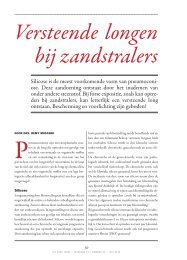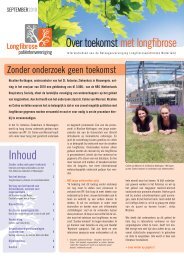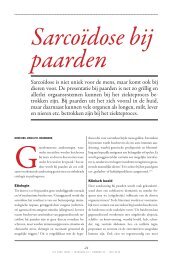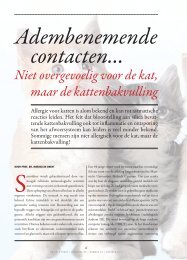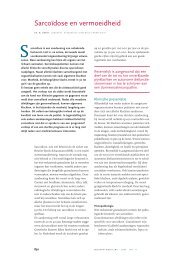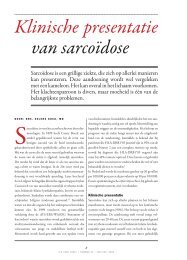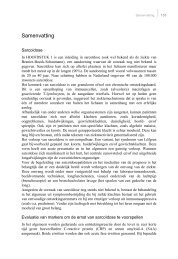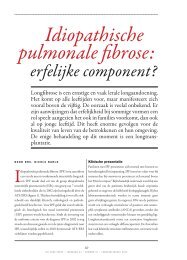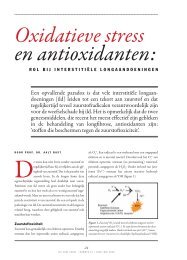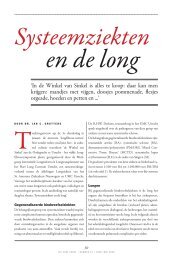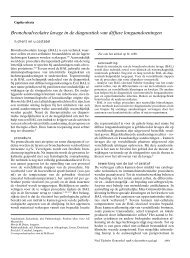Interpretation of bronchoalveolar lavage fluid cytology - ILD care
Interpretation of bronchoalveolar lavage fluid cytology - ILD care
Interpretation of bronchoalveolar lavage fluid cytology - ILD care
Create successful ePaper yourself
Turn your PDF publications into a flip-book with our unique Google optimized e-Paper software.
<strong>Interpretation</strong> <strong>of</strong> BALF <strong>cytology</strong><br />
not grow in culture. Several stains have proved useful in detecting P. carinii. The standard stain for detecting P.<br />
carinii has been a silver stain, such as the Methenamine stain [26]. There are more sensitive stains such as the<br />
immun<strong>of</strong>luorescent stains [27,28] and even polymerase chain reaction has been employed [29]. These more<br />
sensitive, and expensive techniques have not proved necessary for the evaluation <strong>of</strong> most immunosuppressed<br />
patients when examining BALF. They are usually reserved for specimens with a lower number <strong>of</strong> organisms, such<br />
as induced sputum and bronchial wash [27-29]. The Wright-Giemsa and similar stains are used for defining<br />
cellular morphology. A modified Wright-Giemsa can be done within five minutes. It has been shown to detect P.<br />
carinii in the BALF <strong>of</strong> over 70% <strong>of</strong> HIV infected patients with P. carinii pneumonia [30]. It is not as sensitive in non-<br />
HIV infected patients, who have a smaller number <strong>of</strong> organisms [30]. The technique <strong>of</strong> BAL does have an affect on<br />
the yield for P. carinii. The volume <strong>of</strong> instilled <strong>fluid</strong> does not appear to be crucial, since the number <strong>of</strong> P. carinii<br />
organisms is relatively constant during sequential BAL, with increasing volumes <strong>of</strong> BALF instilled [31]. On the other<br />
hand, the area in which BAL is performed has proved important [32]. Multiple <strong>lavage</strong>s or <strong>lavage</strong> directed to the<br />
upper lobe or area <strong>of</strong> most diseases has enhanced the yield <strong>of</strong> BALF for diagnosing P. carinii pneumonia [8,9].<br />
Beyond the organism itself, the cellular differential count has clinical information. Increased neutrophils or<br />
eosinophils are associated with a worse prognosis [33].<br />
Bacterial infections may also be diagnosed by BAL. These include unusual bacterial infections such as Legionella<br />
[34]. BAL has also been used to diagnose routine bacterial infections. For the diagnosis <strong>of</strong> routine infections, one<br />
needs to perform semi-quantitative cultures <strong>of</strong> the BALF [35]. The rationale behind semi-quantitative cultures was<br />
to separate colonization from deep seated infection. Semi-quantitative cultures have proved useful for evaluating<br />
BALF samples for both ventilated [36] and non-ventilated patients [37]. In addition to the standardized BAL<br />
procedure, it is important to culture the <strong>fluid</strong> in a standard manner. Recommendations have been made for the<br />
technique <strong>of</strong> BALF cultures [38]. The examination <strong>of</strong> the cells in bacterial pneumonia usually demonstrates a<br />
marked increase in neutrophils. This is not specific. The use <strong>of</strong> Gram stain to identify bacteria was shown to be<br />
useful in diagnosing pneumonia [35]. Subsequently, CHASTRE proposed counting the number <strong>of</strong> cells with<br />
intracellular organisms (ICO) [39]. The diagnostic importance <strong>of</strong> cells with ICO is still unclear [36].<br />
In conclusion, the analysis <strong>of</strong> cells obtained by BAL can be quite valuable clinically. To improve the<br />
information, one should educate themselves on what they are seeing. This CD-ROM provides excellent<br />
examples <strong>of</strong> the types <strong>of</strong> cells one can see and how to integrate the BAL findings with the clinical<br />
presentation.<br />
The cellular analysis <strong>of</strong> the BALF relies on an accurate counting <strong>of</strong> the various cells involved. Care should be<br />
taken to identify the cells, and differential counting should be done consistently. Although universal<br />
standards are not yet available, it seems obvious that each institution should be sure that the various<br />
readers <strong>of</strong> BALF samples have agreement about their BALF differential counts [19]. Using a standard<br />
technique for performing the BAL and handling the sample will also reduce variability.<br />
References<br />
1. Finley T N, Swenson E W, Curran WS, et al. Bronchopulmonary <strong>lavage</strong> in normal subjects and patients with<br />
obstructive lung disease. Ann Intern Med 1967; 66: 651-658. [no abstract available]<br />
2. Reynolds HY, Newball HH. Analysis <strong>of</strong> proteins and respiratory cells obtained from human lungs by bronchial<br />
<strong>lavage</strong>. J Lab Clin Med 1974; 84: 559-573. [no abstract available]<br />
3. Baughman RP. The uncertainties <strong>of</strong> <strong>bronchoalveolar</strong> <strong>lavage</strong>. Eur Respir J 1997; 10: 1940-1942. [no abstract<br />
available]<br />
4. Dohn MN, Baughman RP. Effect <strong>of</strong> changing instilled volume for <strong>bronchoalveolar</strong> <strong>lavage</strong> in patients with<br />
interstitial lung disease. Am Rev Respir Dis 1985; 132: 390-392. [abstract]<br />
5. Rennard SI, Ghafouri M, Thompson AB, et al. Fractional processing <strong>of</strong> sequential <strong>bronchoalveolar</strong> <strong>lavage</strong> to<br />
separate bronchial and alveolar samples. Am Rev Respir Dis 1990; 141: 208-217. [abstract]<br />
6. Thompson AB, Robbins RA, Ghafouri MA, Linder J, Rennard SI. Bronchoalveolar <strong>lavage</strong> <strong>fluid</strong> processing. Effect<br />
<strong>of</strong> membrane filtration on neutrophil recovery. Acta Cytol 1989; 33: 544-549. [abstract]<br />
7. Garcia JG, Wolven RG, Garcia PL, Keogh BA. Assessment <strong>of</strong> interlobar variation <strong>of</strong> <strong>bronchoalveolar</strong> <strong>lavage</strong><br />
cellular differentials in interstitial lung diseases. Am Rev Respir Dis 1986; 133: 444-449. [abstract]<br />
8. Levine S J, Kennedy D, Shelhamer JH, et al. Diagnosis <strong>of</strong> Pneumocystis carinii pneumonia by multiple lobe,<br />
site-directed <strong>bronchoalveolar</strong> <strong>lavage</strong> with immun<strong>of</strong>luorescent monoclonal antibody staining in human<br />
immunodeficiency virus- infected patients receiving aerosolized pentamidine chemoprophylaxis. Am Rev<br />
Introduction. R.P. Baughman. 2001. 3



